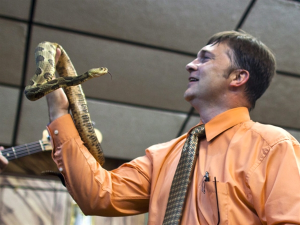
Mishandling Scripture
Just recently Pastor John preached on the beginning of Acts 28. This is the story of how the apostle Paul, a shipwrecked prisoner on the island of Malta, gets bit by a poisonous snake. The local residents of the island keep waiting for him to swell up and die, but he is not harmed at all.
This is one of the three passages used by certain fringe groups to support the practice of snake handling. In some churches they bring out poisonous snakes at some point in the service for people to pick up and handle. They consider the practice of snake handling to be part of their worship.
Luke 10 speaks of treading on the serpents, not picking them up. This is probably an allusion to Genesis 3:15 in which God says to the serpent Satan in the Garden of Eden: “And I will put enmity between you and the woman, and between your seed and her seed; he shall bruise you on the head, and you shall bruise him on the heel.” In Genesis 3 God appears to be speaking of Jesus’ eventual defeat of Satan. And Luke 10:19 also appears to be speaking of the defeat of Satan, but this time by Jesus’ disciples. A quick look at the context shows that Jesus is speaking of the disciples’ ability to cast out demons on their mission to preach the good news in surrounding villages. Even in Luke 10:19 Jesus seems to equate the “serpents and scorpions” with “the power of the enemy.” So treading on serpents and scorpions is probably just symbolic imagery portraying the disciples’ ability to defeat the spiritual forces of darkness.
The third passage on the surface looks to be the passage that most clearly teaches the practice of snake handling. Mark 16:17-18 says, “These signs will accompany those who have believed: in my name they will cast out demons, they will speak with new tongues; they will pick up serpents, and if they drink any deadly poison, it will not hurt them; they will lay hands on the sick, and they will recover.”
There are at least three major problems with using this passage to support the practice of snake handling. First, almost all serious New Testament scholars who believe in the inspiration and inerrancy of Scripture think that Mark 16:9-20 is a later addition to the Gospel of Mark. It is not that people are trying to take verses out of the Bible. It is that these words were added centuries after the Gospel of Mark was originally written. This is a very complex issue, but it basically boils down to the facts that the earliest manuscripts do not have this ending to Mark, and the manuscripts that do have some version of this ending do not agree on what that ending should be. So Mark 16:17-18 is not the best place to find support for the practice of snake handling.
Second, even if Mark 16:17-18 is original, it does not say what snake handlers think it says. It says that “these signs will accompany those who have believed…” It does not say that every believer should exhibit these signs. It does not say that these signs will appear in every time period and in every place where there are believers. It is a very vague statement. It is hard to use this passage to prove that every believer should be able to be unaffected by poison. It is hard to use this passage to prove that every believer or even a lot of believers should be able to reach into a box and pull out a poisonous snake unharmed.
Third, even if Mark 16:17-18 is original and even if it does teach that all believers should be unaffected by poison, it does not teach that snake handling should be a part of regular worship. Even if it were true that believer should be able to pick up poisonous snakes unharmed, that does not mean that we should bring cages of snakes into church and handle snakes in the worship service.
The sad truth is that some of the major leaders of the snake handling movement have died of poisonous snake bites. This is an instance in which the mishandling of Scripture has led to people’s deaths.